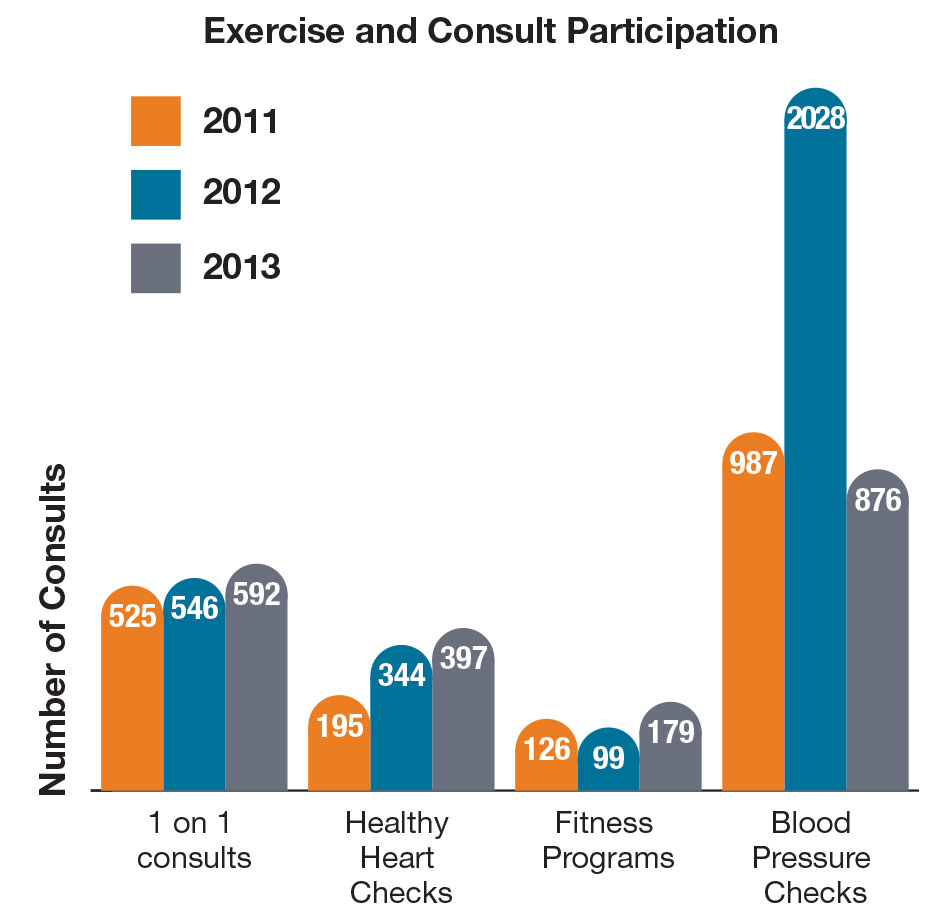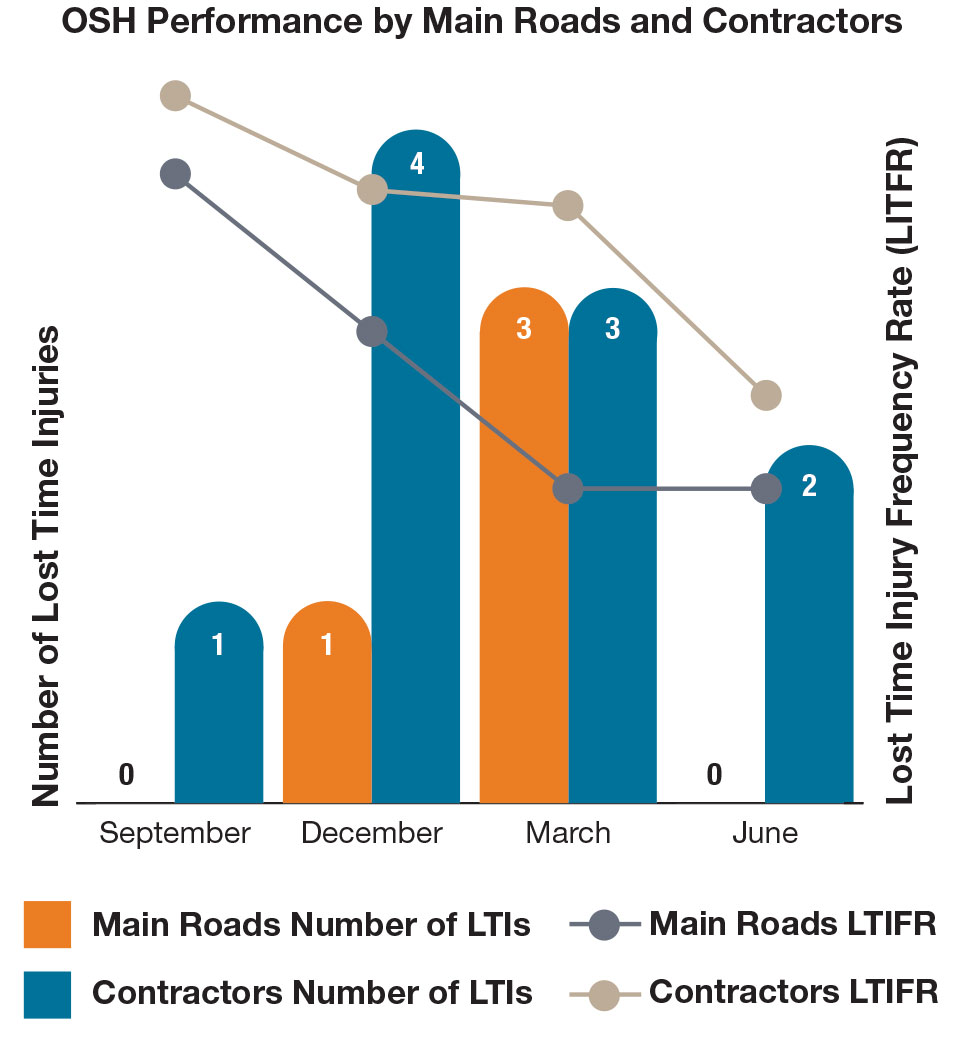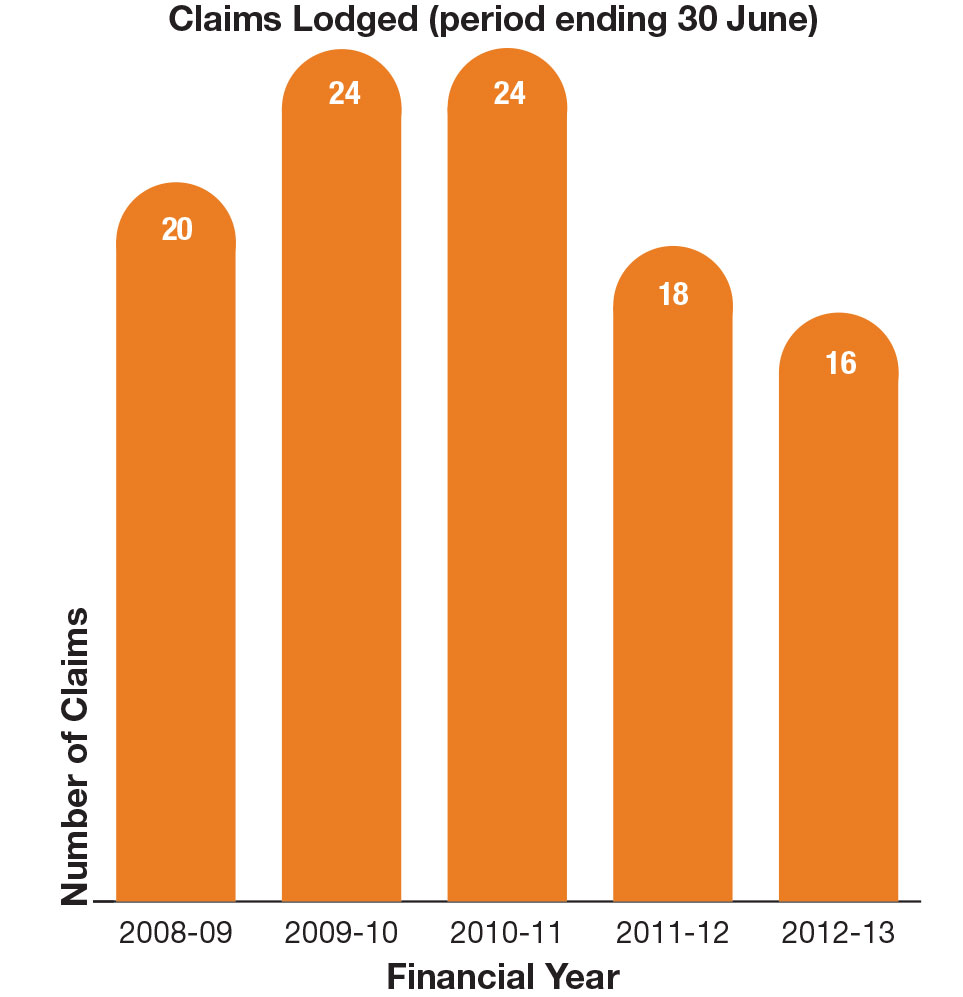
Safety, Health & Wellbeing
Think Safe, Work Safe, Home Safe, Drive Safe, Live Safe
The safety, health and wellbeing of our people is essential to the success and sustainability of our business developing such a culture relies on active systems and processes being in place. It involves a commitment to safety by ‘living’ the ideals in our day to day behaviours.
Key Performance Indicators
Indicators |
2012 Actual |
2013 Target |
2013 Actual |
Result |
Fatalities |
0 |
0 |
0 |
✔ |
Frequency Rate |
2 |
0 or 10% reduction |
2 |
✔ |
Incidence Rate |
0.36 |
0 or 10% reduction |
0.36 |
✔ |
Severity Rate |
0.0 |
0 or 10% reduction |
0.08 |
✘ |
1. Frequency rate is (the number of LTI/Ds over the previous 12 months)*1,000,000 divided by the number of hours worked during that 12 month period.
2. Incidence rate is (the number of LTI/Ds divided by the number of employees)*100.
3. Severity rate is (the number of LTI/Ds that resulted in 60 days or more lost divided by the total number of LTI/Ds)*100
Introduction
Our corporate safety slogan ‘Think Safe – Work Safe – Home Safe’ was expanded in 2012 to include ‘Drive Safe – Live Safe’. This expansion of our safety ethos illustrates the emphasis we place on behavioural safety, safe work practices and ongoing health, and lifestyle education to support the wellbeing of our people within the workplace, in their homes, and in the wider community.
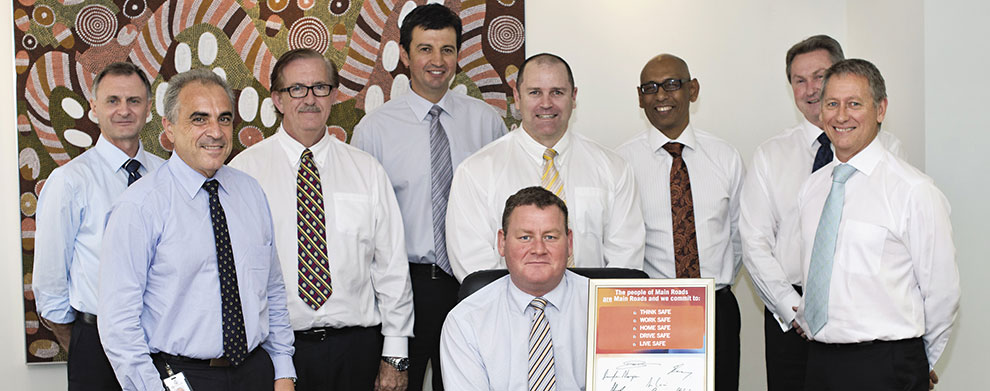
Managing Director, Steve Troughton launches the Safety Commitment initiative with the Corporate Executive.
Key Achievements
Our Commitment and Engagement
We are committed to providing a safe and healthy work environment for its people that is supported by strong collaborative relationships and demonstrative leadership at all levels of the organisation.
The Safety Health and Wellbeing Management System is a multi-layered committee structure at the Corporate, Directorate and Regional levels. Its management plans are based on corporate initiatives, local issues and consultation, ensuring that we are aware of our risks and can manage them effectively. Our committees comprise of executives, senior management, employees and elected safety and health representatives. Regular communication is circulated to the organisation through a Safety Health and Wellbeing (SHW) communique that allows all staff to be informed of corporate SHW matters and upcoming events.
We take the position that safety is everyone’s responsibility and as such encourage a proactive safety culture through participation. All Corporate policies and procedures are reviewed and made available to staff for comment. In some circumstances, working groups have been established to represent staff from all areas of the organisation to allow for consultation. Initiatives and feedback from the working groups are referred directly to the Corporate SHW Committee for consideration.
An initiative that arose from the SHW communication working group in 2012 was the Safety Commitment Poster and Card. The initiative invited all staff to sign a commitment poster and carry a commitment card that served as a visible reminder not to compromise on safety. This concept not only demonstrated leadership commitment but also allowed individual employees to commit to ensuring their own safety and that of their colleagues. In order to promote a positive safety culture and demonstrate commitment to safety at the highest level of the business, Corporate Executive members were the first to sign and display their safety commitment poster.
Safe Work Week 2012
As in previous years, we proudly participated in Safe Work Week activities in 2012. Our corporate focus is not just on promoting safety but also provides access to a wide range of health and wellbeing initiatives and information. As part of the 2012 Safe Work Week activities, a permanent resource centre was launched within our head office allowing staff to access a wide range of health and wellbeing related information.
The weeklong event included presentations on the topics of ‘Lifestyle and Cancer’; ‘Secret Men’s Business’; ‘De-mystifying Mental Health’; and ‘Suicide Awareness and Prevention’.
Corporate SHW Management Systems Training
Formally known as ‘OSH for Line Managers’, this is a tailored one-day intensive training course that is mandatory for all managers. The course contains five modules including ‘Safety Law’; ‘Safety Management Systems’; ‘Hazard Management’; ‘Incident and Injury Management’; and ‘Safety Leadership, Culture, Communication and Consultation’.
The objectives of the course are to make line managers aware of their legal responsibilities and of potential exposures to legal risk that could impact the organisation. The course also aims to provide managers with SHW management skills enabling them to implement the SHW management systems in their area of responsibility and to effectively carry out their SHW responsibilities. As it is mandatory, all managers must also undergo refresher training every five years.
Taking Proactive Safety, Health and Wellbeing Preventative Measures
At Main Roads we take a proactive approach to helping our people manage their health and wellbeing and as such we continue to expand upon our health and wellbeing program.
The graph below shows the participation of our employees in various initiatives offered by the Health and Wellbeing service provider.
Wellbeing workshops continue to be rolled out across the organisation based on overwhelmingly positive feedback from employees. The workshops are designed to provide employees with the skills and motivation to better manage anticipated changes and additional pressures felt through changes in their personal and professional environments. The workshops have been well attended by employees and we are now working towards adapting these workshops to e-Learning.
Main Roads’ corporate health and wellbeing calendar once again gave employees the opportunity to participate in community charity events such as the City to Surf, Freeway Bike Hike, Great Bike Ride, HBF Run for a Reason and various State Government-endorsed Corporate Cup activities. Our corporate calendar also notes dates for national awareness campaigns such as ‘R U OK’ Day, Biggest Morning Tea and Stroke Week. We encourage staff to take part in organised activities to raise funds for such charities or to participate in presentations or activities that will assist the organisation to raise awareness and promote healthy behaviours or interventions.
Our health and wellbeing program service provider continues to educate staff in the use of the online wellness tracker which enables them to track and measure their own progress towards improving their health and wellbeing. This tool has become popular with employees who use it to record their exercise regimes, weight, BMI, glucose and blood pressure levels. Flu vaccinations, skin cancer screenings and healthy heart checks were once again offered to employees, with a total of 543 employees participating across all three programs.
In addition to the resource centre now available for accessing health and wellbeing related information, we continue providing a confidential Employee Assistance Program. This is an organisation-funded counselling service which provides support to employees who may be experiencing problems, affecting their job performance or personal lives.
As a preventative initiative, ergonomic assessor training was offered to selected staff to enable them to provide brief assessments and make informed workstation adjustments for staff in their work areas.
Third Party and Work Safe Plan Certification
In May 2013, our Occupational Safety and Health Management System was assessed and recommended for re-certification to AS/NZS 4801 which is the Australian and New Zealand Standard for Safety Management Systems. Corporately, we proudly maintain our WorkSafe Plan – Gold Certification.
One Life Pledge
In 2012, we became a pledge partner in support of the State Government’s ‘One Life Suicide Prevention Strategy’. As a ‘Silver’ pledge partner, we are committed to distributing suicide prevention awareness and stigma reducing messages to all staff to coincide with World Suicide Prevention Day and ‘R U OK’ Day. Furthermore, relevant members of the workforce have been trained in Mental Health First Aid and Suicide prevention to ensure that our ‘One Life Champions’ within the workplace can act as an initial support person to fellow employees.
Performance Review
Our reporting processes focus on a combination of lag and lead indicators to capture the outcomes of incidents and identify the proactive behaviours that our employees engage in to determine and manage hazards in the workplace. Some of these indicators include hazards reported, close-out of these hazards, attendance at SHW committee and toolbox meetings, induction of new staff, and undertaking workplace inspections.
Lost Time Injuries
Lost Time Injury/Day (LTI/D) is defined as an injury or disease that results in the affected employee being unable to work for one full shift or longer. The following graph shows our performance and that of our contractors during the year:
* We rely heavily on all contractors to provide accurate information to Main Roads within the required timeframe. LTI Contractor statistics are accurate at the time of reporting and are considered to be estimated.
During the past year, we sustained four LTI/D, resulting in a Lost Time Injury/Disease Frequency Rate (LTIFR) of two serious injuries sustained per million hours worked. Our contractors also sustained 11 LTI/D resulting in their LTIFR to decrease from 5.4 to 2.6 serious injuries sustained per million hours worked.
Although our ultimate goal is for zero harm, we had no change in the number of lost time injuries this year. However, we had fewer non-lost time injuries which are an improvement on our performance from last year. The majority of our serious incidents involved vehicles, equipment, and manual tasks/ergonomics. In the next year, we will again be focusing our attention on minimising the likelihood of these risks recurring.
A breakdown of incidents by type is outlined below:
Summary of all incidents by type and severity
Incident Type |
Lost Time Injuries |
Non Lost Time Injuries |
Near Miss Incidents |
Total |
Vehicle |
1 |
6 |
11 |
28 |
Equipment |
– |
6 |
12 |
18 |
Ergonomics/Manual Tasks |
3 |
11 |
2 |
16 |
Other |
– |
8 |
6 |
14 |
Slips/Trips/Falls |
– |
7 |
4 |
11 |
Human Factors |
– |
2 |
9 |
11 |
Bites/Stings |
– |
2 |
1 |
3 |
Health |
– |
– |
1 |
1 |
System Failure |
– |
– |
1 |
1 |
Total |
4 |
42 |
47 |
103 |
Workers’ Compensation and Injury Management
During the past year, we incurred 16 workers’ compensation claims. Of these, five have been finalised, and two claims have been pended. One claim lodged this financial year was declined and has not been included in the 16 claims reported. We had 33% of injured workers (lost time claims) returning to work within 13 weeks and 33% of injured workers (lost time claims) returning to work within 26 weeks. The graph below compares the total number of claims lodged this financial year to the last five years.
Recognition
2012 IPAA Achievement Awards:
- Finalist ‘Department of Health Best Practice in Health and Wellbeing’
2012 IPAA Lonnie Awards:
- Joint Award led by Department of Commerce for Occupational Safety, Health and Injury Management – 2012 Annual Report
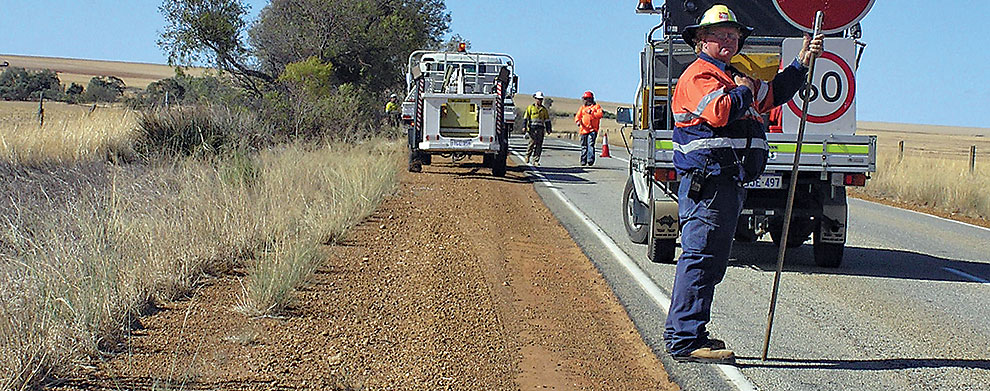
Looking Ahead
- Develop a five-year SHW Strategic Plan.
- Review SHW Management System in alignment with the impending Workplace Safety and Health Laws (WA).
- Implement an electronic hazard and incident reporting management system.
- Achieve 100% of managers completing the SHW Management Systems Training.
- Focus on developing Safe Work Method Statements and Job Safety Analysis.
Case Study
Developing Safety Awareness in the Goldfields-Esperance Office
Safety is on everyone’s mind in the Goldfields-Esperance Region. The Region started its Safety and Team Development days in late 2011. This was due to an increasing trend in the number and type of safety incidents recorded in the early stages of deployment of the new Integrated Services Arrangements (ISA). Read more...



